Title: Vengeance is Mine: The Mountain Meadows Massacre and its Aftermath
Authors: Richard Turley and Barbara Jones Brown
Publisher: Oxford University Press
Genre: Religious History
Binding: Hardcover
Pages: 520
Price: $34.95
ISBN: 978-0195397857
Reviewed by Amanda Ray for the Association for Mormon Letters
The Mountain Meadows Massacre is something I have been vaguely aware of for most of my life, usually with some kind of caveat that the “mainstream” portrayal was incorrect, but never getting additional details. Since the Massacre was portrayed briefly in the recent TV adaptation of Under the Banner of Heaven, and with the publication of the previous volume to this one, Vengeance Is Mine: The Mountain Meadows Massacre and its Aftermath is out at a time of renewed interest and possibly a few more open minds to untangle the stories and be able to sit with the result. This is a book worth reading.
It’s almost astounding to read the account of the misinformation of the Mountain Meadows Massacre and how long it took for those responsible to be brought to justice and not think to some degree of current events. Some of the misinformation could be blamed on the technology of the time, but also due to the prejudices of the day against both Mormons and the indigenous peoples of America and the fact that the American Civil War happened and distracted most of the players in the story from being able to further investigate in a timely manner. But the story Turley and Brown recount shows that memory runs deep, and the demands of justice continued to poke until they were finally met to some degree.
Vengeance Is Mine recounts the massacre itself and stresses that the prior book the authors contributed to, Massacre at Mountain Meadows, is more in-depth. However, if someone hasn’t read it, they’ll be caught up quickly. It’s obvious the authors are building from a wealth of information, and it really made me interested to go back and read the initial volume to give me even more detail. The recount of the horrible event is heart-rending enough, I can only assume their deeper dive into the previous book is even harder to read. But Turley and Brown do an admirable job of giving the reader a wide view of the primary accounts as the massacre unfolded and show how shocking the aftermath was for the communities involved and the country as a whole. The narrative tracks how the Church of Jesus Christ of Latter-day Saints, Washington D.C., and those on the periphery of the massacre reacted to it and dealt with the aftermath.
The latter part of the book turns into a courtroom drama, as a major player in the massacre is finally tried, and it’s the kind of courtroom drama where you want to yell at the screen all the things you see going wrong and have no power to do anything about. It also demonstrates how a savvy district attorney was able to maneuver into getting a major contributor to the massacre convicted – that he violated his faith, and his fellow church members saw that. This D.A. even called Brigham’s counselor as a witness, signaling the church was cooperating. Justice took 20 years in the making, but it came – despite the misconceptions that remained for generations after.
Vengeance Is Mine ends with stories on how even decades later, the Paiute considered the land of the massacre haunted. That also decades later some missionaries were killed in part because of the Mormon connection and blame for the massacre. How the area of Arkansas that the emigrants were from and where the surviving children were eventually returned to, held a long-standing grudge against any Mormon presence. Also, how other major figures who participated in the massacre and had varied connections and admissions of guilt were hounded by the massacre for the rest of their lives. It’s a disturbing way to end the narrative; but it’s based in the truth left behind. This is the kind of book that will sit with you for a while as you let the horrors and the injustices further sink in.

